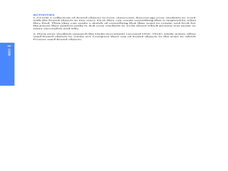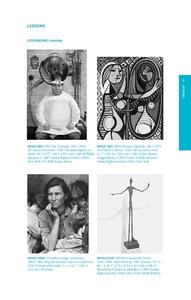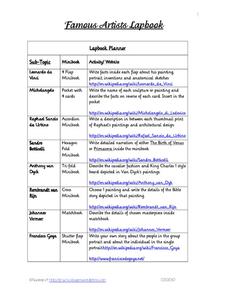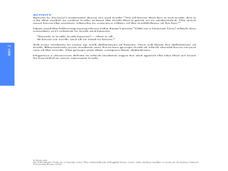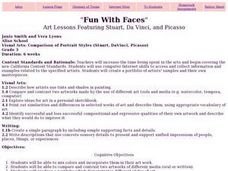Curated OER
Innovations in Media
Students analyze Pablo Picasso's art. In this Picasso art analysis lesson, students define collage and analyze Picasso's work in different mediums. Students complete image based discussion activities. Students use found objects to create...
Curated OER
Portraiture
Students analyze portraiture with a focus on the work of Pablo Picasso. In this portraiture analysis lesson, students explore the conventions of portraiture and the elements of pose, gesture, expression, costume, and setting. Students...
Curated OER
Identity
Students analyze identify in art. In this art analysis lesson plan, students discuss what identify means and discuss how Otto Dix, Pablo Picasso, Dorothea Lange, and Alberto Giacometti represent identities in portraiture. Students...
Curated OER
Picasso's "The Dog"
Learners draw a dog. In this drawing lesson, students discover how to tap into their right brain dominance by sketching a picture upside down. Learners draw a picture resembling Picasso's "The Dog".
Curated OER
Picasso's "The Butterfly"
Pupils draw a butterfly. For this drawing lesson, students explore a drawing upside down. Pupils sketch a butterfly while the image is reversed to tap into their right brain dominance.
Curated OER
Pablo Picasso
Fifth graders research Pablo Picasso and apply what they know in a created piece of artwork. They create artwork out of geometric shapes such as triangles, rectangles and circles. They access the Internet to research Picasso and complete...
Curated OER
Oh Picasso!
Pupils identify the painter Picasso as a famous Spanish cultural figure, name at least one of Picasso's painting styles and describe aspects of Picasso's Blue Period. They create their own Blue Period inspired work of art.
Curated OER
Making Picasso Faces
Third graders read stories about Picasso and see pictures of his work. Students brainstorm all the different kind os faces that one can make (clown, alien, etc...). They then get two pieces of drawing paper to make two different faces...
Practical Pages
Famous Artists Lapbook
Create mini books with some of the most beautiful and well-known masterpieces of our time. Learners read short paragraphs about famous artists such as Pablo Picasso, Leonardo da Vinci, and Johannes Vermeer, and create different kinds of...
Curated OER
Family Responsibility and Commitment
Students are introduced to Picasso and how he created Baboon and Young, and interpret the expressive content of the work. They discuss and define what a family unit consists of, and form conclusions of their own. Students identify and...
Curated OER
Picasso's Art Styles
Students explore the life and artistic contributions of Pablo Picasso. They create a clay animation depicting one of Picasso's art periods.
Curated OER
Rhythm and Art: Elements of Art
High schoolers discover the three elements of art. In this visual arts lesson, students examine line, shape, and color of works by Torres-Garcia and Picasso. High schoolers then identify the elements of art in works by other artists.
Curated OER
Papier Colle Printmaking
Papier Colle is a printmaking technique used by many famous artists, including Georges Braque and Henri Matisse. Have your class master this art using this fantastic resource. What a fun, new art technique to learn!
Curated OER
Family Responsibility and Commitment
Learners discuss the meaning of family and how they can community love and affection. Using an analysis of the work of Picasso, students define who is in their family. They discuss the various ways family members express their affection...
Curated OER
The Artist at Work
Students analyze art pieces of Picasso and Diego Velazquez to consider artists self-portraits using their work tools. In this art analysis lesson, students complete introductory and image based discuss to consider how an artist chooses...
Curated OER
Action/Reaction: Art and Politics
Students examine three images that were responses to social and political turmoil World War I and II. In this political art lesson, students analyze and discuss the example art. Students create a word poem, a collage, and their own...
Curated OER
Exploring War Themes in Art and Poetry
What is war? Students discuss the ethical dilemma of war by viewing Picasso's painting entitled "Guernica" and write down everything they see in the painting. Then they choose one emotion that best summarizes their emotional response to...
Curated OER
Guernica: Testimony of War
Students analyze artistic decisions (use of visual elements, composition, symbolism) They determine how Picasso's choices affected the communication of a powerful anti-war message
Curated OER
Picasso; Comparing Blue and Rose Periods
Third graders research Picasso's art career. They use a word processor to create a Venn diagram which compares Picasso's Blue and Rose Periods.
Curated OER
Painting Modern Life
Pupils analyze two works by Pablo Picasso and how he represents female figures. In this art analysis lesson, students analyze the female figures in the two artworks and discuss them. Pupils research a topic of social importance and...
Curated OER
Fun With Faces: Stuart, Da Vinci and Picasso
Third graders conduct research and review art work to compare the styles of Stuart, Da Vinci and Picasso. They develop and compile a portfolio including masterpieces of these artists and original works. Students compose detailed...
Curated OER
Survey of Spanish and Latin American Artists
Tenth graders explore the art work of Dali and Picasso. In this Art lesson, 10th graders analyze various pieces created by these men. Students write a description of the painting they were assigned.
Curated OER
Look Before You Think: How To Appreciate a Painting
Students develop an elementary understanding of the history of art. They study the basic elements of a painting including perspective, composition, color, light and symbolism. They look at each selected painting and analyze it, moving...
Curated OER
Protesting through Art
Students experience critiquing, analyzing, and comparing different works of art from different eras. They discuss how these works can or can't be considered a form of protest and assess how to evaluate their own judgments and values on...


